This is where you’ll find everything you need to know about the game.
This is the multi-page printable view of this section. Click here to print.
Information
- 1: Overview
- 2: How To Play
- 2.1: Core Concepts
- 2.2: The Board
- 2.3: Cards
- 2.4: Adversaries
- 2.5: Obstacles
- 2.6: The Shop
- 2.7: Your Collection
- 3: FAQ
- 4: Reference
- 4.1: Glossary
- 4.2: Descriptors
- 4.3: Status Effects
- 5: Media
1 - Overview
Welcome to The Scene, a single-player, rogue-like deck-builder where you create a “scene” to impress a “fandom.” Your goal is to celebrate and remix pop culture, progressing through a series of encounters by building a powerful deck of characters and navigating the challenges they present.
The Objective
The main goal in each encounter is to accumulate ![]() (Culture) to meet the fandom’s threshold, while managing your
(Culture) to meet the fandom’s threshold, while managing your ![]() (Cheese) level to avoid bombing.
(Cheese) level to avoid bombing.
Core Concepts
 Hype: The primary resource used to play cards from your hand.
Hype: The primary resource used to play cards from your hand. Culture: The main scoring metric. You win an encounter by reaching the required
Culture: The main scoring metric. You win an encounter by reaching the required  Culture score.
Culture score. Cheese: A penalty resource representing tackiness or controversy. If you accumulate too much, you lose the encounter.
Cheese: A penalty resource representing tackiness or controversy. If you accumulate too much, you lose the encounter. Accolades: A currency earned by winning encounters, used in the shop to buy new cards and improve your deck.
Accolades: A currency earned by winning encounters, used in the shop to buy new cards and improve your deck.
Game Flow
A run in The Scene consists of a series of encounters against different Adversaries (fandoms).
- Deck Building: You start by drafting cards from booster packs to create your initial deck. Between encounters, you’ll use
 Accolades to buy more cards and boosters in the shop.
Accolades to buy more cards and boosters in the shop. - Encounters: You’ll face a series of fandoms, each with its own
 Culture goal and
Culture goal and  Cheese limit.
Cheese limit. - Playing Cards: You’ll play cards representing people, characters, and groups onto a board of four lanes. Cards automatically move up the lanes each turn.
- Scoring: When a card reaches the top of a lane, the next time it would move it scores, adding its
 Culture and
Culture and  Cheese to your totals for the encounter.
Cheese to your totals for the encounter. - Winning and Losing: You win an encounter by reaching the
 Culture threshold. You lose if your
Culture threshold. You lose if your  Cheese exceeds the tolerated level, or if you run out of cards to play or draw.
Cheese exceeds the tolerated level, or if you run out of cards to play or draw.
This overview provides the basics. The following pages in the How to Play section will dive into the detailed mechanics of cards, obstacles, adversaries, and more.
2 - How To Play
This section tells you everything you need to know about how to play The Scene. Get started with the Overview for a high-level summary, or dive into the detailed sections below to master the mechanics.
2.1 - Core Concepts
This page explains the fundamental resources, game states, and the overall structure of a run in The Scene.
Core Resources
Your success depends on managing four key resources:
-
 Hype: This is the energy you need to play cards. Represented by a green star, Hype is your primary in-encounter resource. You’ll start each encounter with a set amount of Hype, and many card abilities will help you gain more. Any leftover Hype at the end of a victorious encounter is converted into Accolades.
Hype: This is the energy you need to play cards. Represented by a green star, Hype is your primary in-encounter resource. You’ll start each encounter with a set amount of Hype, and many card abilities will help you gain more. Any leftover Hype at the end of a victorious encounter is converted into Accolades. -
 Culture: This is your score, represented by a purple trophy. To win an encounter, you must accumulate enough Culture to meet the current Adversary’s Culture Threshold. Culture is primarily gained when your cards successfully “score” by reaching the top of a lane.
Culture: This is your score, represented by a purple trophy. To win an encounter, you must accumulate enough Culture to meet the current Adversary’s Culture Threshold. Culture is primarily gained when your cards successfully “score” by reaching the top of a lane. -
 Cheese: This represents controversy, tackiness, or just plain bad vibes. Represented by a slice of orange cheese, this is a penalty you want to avoid. If your total Cheese ever exceeds the Adversary’s Cheese Tolerated threshold, you immediately lose the encounter. Certain cards and abilities generate Cheese, so manage it carefully!
Cheese: This represents controversy, tackiness, or just plain bad vibes. Represented by a slice of orange cheese, this is a penalty you want to avoid. If your total Cheese ever exceeds the Adversary’s Cheese Tolerated threshold, you immediately lose the encounter. Certain cards and abilities generate Cheese, so manage it carefully! -
 Accolades: This is the meta-currency of the game, earned by winning encounters. You use Accolades in the Shop Phase between encounters to purchase new cards, booster packs, and other upgrades to build a stronger deck for your run.
Accolades: This is the meta-currency of the game, earned by winning encounters. You use Accolades in the Shop Phase between encounters to purchase new cards, booster packs, and other upgrades to build a stronger deck for your run.
Game Structure
A single playthrough of The Scene is called a “run.” A run is composed of a series of encounters against Adversaries, with a shop phase in between each.
Encounters & The Board
Encounters are where the core gameplay happens. The board is composed of four vertical lanes, each with five slots. You play cards from your hand to the bottom slot of a lane.
The Shop Phase
After successfully completing an encounter, you’ll enter the shop. Here, you can spend your hard-earned Accolades to improve your deck. The shop offers:
- Booster Packs: Packs of cards that let you discover new characters and abilities.
- Individual Cards: Sometimes specific cards are for sale.
- Rerolls: Don’t like what’s on offer? You can pay to refresh the shop’s inventory.
Deck-building is key, and the shop is where you make the strategic decisions that will shape your run.
Turn Structure
Each turn in an encounter is broken down into several phases:
- Start of Turn: Some abilities trigger, and the Adversary may deploy an Obstacle to the board.
- Draw Phase: You draw one card from your deck.
- Play Phase: This is your main action phase. You can:
- Play one card from your hand to the bottom of a lane.
- Attach Actor or Writer cards to Role cards already on the board.
- Activate special abilities on your cards.
- Instead of playing a card, you may discard one card for a small Cheese penalty.
- Movement Phase: All cards on the board that weren’t just played or interacted with move up one slot in their lane. If a card moves past the top slot, it scores!
- End of Turn: End-of-turn abilities trigger, and play proceeds to the next turn.
2.2 - The Board
The game screen of The Scene is where all the action happens. It’s divided into several key areas, each providing important information and controls.
Board Anatomy
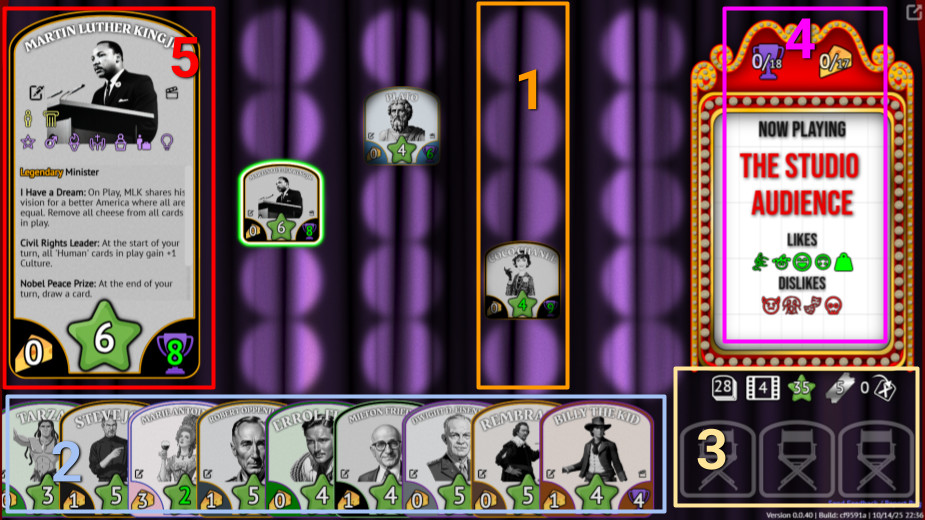
Here is a breakdown of the numbered areas in the image above:
-
A Lane: The main play area consists of four vertical Lanes. Each lane has five slots. You play cards onto the bottom slot, and they move up one slot each turn. When a card moves past the top slot, it scores.
-
Your Hand: This area at the bottom of the screen displays the Cards you currently have available to play. Clicking on a card will populate the info area with more details (see #5). Once a card is selected, you may play it by clicking on an open bottom slot, the crew area (#3), or onto another card on the board (see portrayals).
-
Player Info Area: This section shows your current status, from left to right:
- The number of cards left in your Deck.
- The number of the current Turn.
- Your current
 Hype total.
Hype total. - Your current
 Accolades total.
Accolades total. - The number of cards in your deck and discard pile.
Beneath this information is the Crew Area. This is a special area where you can play up to three Crew cards. Cards in the Crew Area provide powerful, persistent effects that last for the entire run. Cards played here carry over between encounters.
-
Adversary Info Area: This panel on the right side of the screen gives you the details on your current opponent, from top to bottom:
- Your current
 Culture total and the total required to win
Culture total and the total required to win - Your current
 Cheese total and the threshold at which you will lost
Cheese total and the threshold at which you will lost - The Adversary’s name (in this example The Studio Audience)
- Tags and Archetypes the adversary Likes and Dislikes. Matching these tags with scoring cards will bestow bonuses and penalties, respectively.
- This adversary Likes:
 Animated,
Animated,  Buffoon,
Buffoon,
 Comedic,
Comedic,  Quirky, and
Quirky, and  Slapstick
Slapstick - This adversary Dislikes:
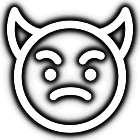 Villainous,
Villainous,  Terrifying,
Terrifying,
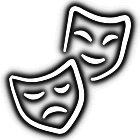 Dramatic, and
Dramatic, and  Horror
Horror
- This adversary Likes:
- Your current
-
Card / Obstacle Info Area: When you select a card or an obstacle on the board or in your hand, this area on the left provides a detailed view. You can see all of its stats, descriptors, and the full text of its abilities. If a card has an activatable ability, the button to use it will appear here. The elements you can see in order from top to bottom:
- Card Name (Martin Luther King Jr.)
- Card Portrait
- Writer and Actor slots. These appear on cards that are able to be portrayed by an
 Actor
or
Actor
or  Writer card.
Writer card. - Archetypes in yellow (in this example
 Human and
Human and  Historical Figure)
Historical Figure) - Tags in lavender (in this example tags include
 Iconic,
Iconic,  Male, and
Male, and  Heroic)
Heroic)
Lane Closure
Some effects may cause a lane to be Closed. This effectively temporarily removes the lane (and anything in it) from the game until the lane is re-opened. The specific effects are as follows:
- Cards may not be played into a Closed Lane.
- Cards already in a closed lane do not move during the Player’s turn.
- Cards inside a Closed Lane will not have most of its abilities trigger.
- The lane is effectively “invisible” to abilities and effects.
Note that if all lanes are ever closed and you can’t open them back up, you will immediately lose the encounter!
2.3 - Cards
Cards are the heart of The Scene, representing the vast universe of pop culture characters, real-life personalities, and groups you can recruit for your scene.
Card Anatomy
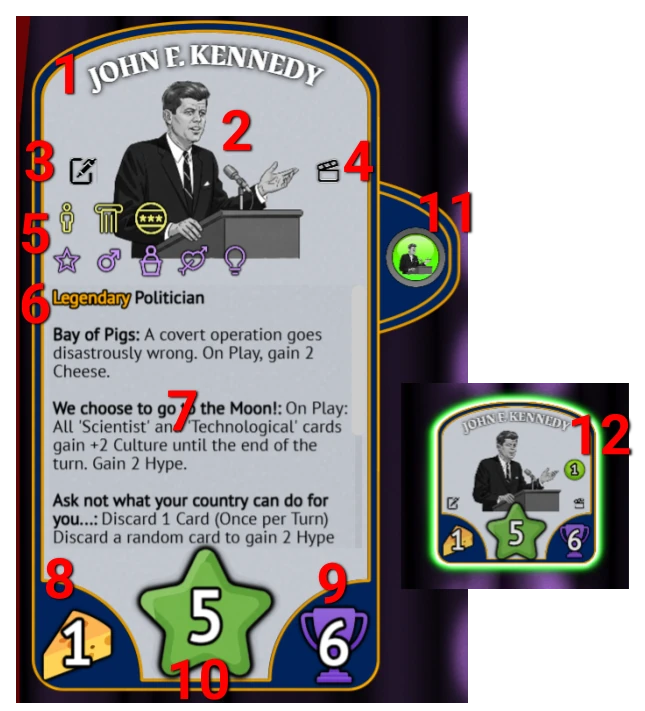
There are two representations of a card in The Scene. There is the card itself, which appears in your hand and in the board’s lane areas, and the card info panel, which displays detailed information about the currently selected card. This area is used for Obstacle details, as well.
Each card has several key properties that define its function and feel:
- Name: Identifies the card.
- Portrait: A graphical depiction of the person (or entity) represented by the card.
- Writer Slot: An icon that appears if a writing portrayal is able to be played on this card.
- Actor Slot: An icon that appears if an acting portrayal is able to be played on this card.
- Descriptors: Tags & archetypes that define a card’s traits (e.g.
 Actor,
Actor,  Fictional,
Fictional,
 Science Fiction,
Science Fiction,  Professional (Law Enforcement)). These are crucial for synergies and for how Adversaries react to your cards. Liked descriptors will be shown in green, while Disliked descriptors will
appear in red. You can see a comprehensive listing of all Tags and Archetypes on the Descriptors reference page.
Professional (Law Enforcement)). These are crucial for synergies and for how Adversaries react to your cards. Liked descriptors will be shown in green, while Disliked descriptors will
appear in red. You can see a comprehensive listing of all Tags and Archetypes on the Descriptors reference page. - Short Description: This includes both the card’s Rarity (Common , Uncommon , Rare , Legendary ) and the primary feature of the card as derived from its tags and archetypes. Rarity determines how often a card appears and generally correlates with its mechanical complexity and power.
- Abilities: The unique effects the card can perform. These are what make each card special. Most abilities trigger automatically, but some are Activated manually.
 Cheese: The base
Cheese: The base  Cheese value the card contributes when it scores.
Cheese value the card contributes when it scores. Culture: The base
Culture: The base  Culture value the card contributes when it score
Culture value the card contributes when it score- Cost: The amount of
 Hype required to play the card from your hand.
Hype required to play the card from your hand. - Activated Ability Button: This button appears only when a selected card has an Activated ability. If the button is enabled, you can click it to use the ability.
- Activated Ability Indicator: This small icon appears if the card has an Activated ability available to use. It allows you to quickly scan the game board for cards with actions you can take.
Cards also have a background color and a border color. The background color is simply cosmetic and is meant to be an abstract reflection of the person depicted on the card. It has no mechanical value. The border color matches the Rarity of the card. In this example, John F. Kennedy is Legendary , so his border is gold.
Discovering Cards and Abilities
A key part of the fun in The Scene is discovering what each character can do. When you first encounter a card, its abilities will be hidden from you.
- Reveal on Use: An ability is only revealed the first time it is triggered or activated. Until then, you’ll see a placeholder (like
???) where the ability description should be. - Persistent Discovery: Once an ability is revealed, it stays revealed forever. This knowledge persists across all your future runs, allowing you to build up your understanding of the game’s vast pop culture universe over time. You can see everything you’ve unlocked by viewing your collection from the game’s main menu.
- Easter Eggs: Some abilities are completely hidden and don’t even show a placeholder. These are rare “easter eggs” waiting to be discovered through clever play and specific interactions!
Card Types
Cards come in several varieties, each with a specific role to play.
- People: The general term for any card representing a single individual, whether a real person or a fictional character.
- Roles: Cards representing fictional characters or historical figures (e.g.
Tom Sawyer,Abraham Lincoln). These cards have special slots for attachments. - Actors & Writers: Cards with the
 Actor or
Actor or  Writer archetypes can be attached to Role cards to create a Portrayal.
Writer archetypes can be attached to Role cards to create a Portrayal. - Groups: Cards with the
 Group Group archetype represent a collective (e.g., a band, a comedy troupe). They cannot participate in portrayals.
Group Group archetype represent a collective (e.g., a band, a comedy troupe). They cannot participate in portrayals. - Crew: Cards with the
 Crew archetype can be played to a separate Crew Area instead of the main board. They provide powerful, persistent effects that can define your strategy for the entire run.
Crew archetype can be played to a separate Crew Area instead of the main board. They provide powerful, persistent effects that can define your strategy for the entire run.
Portrayals: Bringing Roles to Life
A key mechanic in The Scene is attaching Actor and Writer cards to Role cards. This creates a Portrayal, which modifies the Role’s Culture and Cheese output.
- Attaching: You can play an Actor or Writer from your hand onto a Role card that is already on the board.
- Portrayal Types:
- Canonical: The actor/writer is the one who actually portrayed/wrote the role in the real world (for example if you were to play Charlie Chaplin onto The Tramp). This gives a significant 50% Culture bonus!
- Parody: The actor/writer portrayed the role in a parody setting. This gives a 25% Culture bonus, and any
 from the portrayal is ignored when scoring!
from the portrayal is ignored when scoring! - Normal: A standard casting where the talent and role share some logical descriptors. No bonus or penalty.
- Miscast: A wacky casting where the talent and role have very little in common. This incurs a 25% Culture penalty and adds +2 Cheese.
Important
Card Abilities & Statuses
- Abilities: These are the special rules on cards, defined by a trigger (like “when played” or “when this card scores”), conditions, and effects. Most are automatic, but some rare abilities can be activated by the player. Usually, when an ability triggers, you will see a speech bubble appear on the card on which it triggered.
- Status Effects: Cards can be affected by temporary or permanent statuses that change their behavior. For a full list, see the Status Effects reference page.
2.4 - Adversaries
Adversaries represent the opposition you face in each encounter. They are the embodiment of a specific fandom, a cultural movement, or a final boss, and they set the rules and victory conditions for the encounter.
Fandoms & Bosses
- Fandoms: These are the standard adversaries you will face for most of your run. Each represents a specific group of fans with their own tastes and preferences (e.g., “Sci-Fi Enthusiasts,” “Horror Aficionados”).
- Bosses: After defeating a series of Fandoms, you will face a final Boss. These are much tougher encounters representing a major “Cultural Event” and serve as the climax of your run. Examples might be “The Moon Landing” or “The World’s Fair”.
Victory and Defeat
Each Adversary defines the win and loss conditions for the encounter:
- Culture Threshold: This is the amount of
 Culture you must score to win the encounter.
Culture you must score to win the encounter. - Cheese Tolerated: This is the maximum amount of
 Cheese you can accumulate. If your
Cheese you can accumulate. If your  level ever exceeds this number, you lose immediately.
level ever exceeds this number, you lose immediately.
As you progress through a run, the Fandoms you face will become more difficult, with higher ![]() requirements and lower
requirements and lower ![]() tolerance.
tolerance.
Influencing the Scene
Adversaries are not passive observers; they actively influence the game.
Liked & Disliked Descriptors
Every Adversary has a set of Liked and Disliked descriptors. These preferences are key to maximizing your score.
- When a card scores, every descriptor on that card (and any attached cards) is checked against the Adversary’s lists.
- For each matching Liked descriptor, you gain +1 bonus
 .
. - For each matching Disliked descriptor, you gain +1 additional
 .
.
Playing to the Fandom’s tastes is a critical strategy for success!
Deploying Obstacles
Adversaries are also responsible for deploying Obstacles to the board. Each Adversary has a thematic pool of obstacles they can use to disrupt your plans. At the start of each turn, there is a chance the Adversary will place a new obstacle on the board, forcing you to adapt your strategy.
2.5 - Obstacles
Obstacles are non-card entities that the Adversary deploys to the board to disrupt your scene. They represent challenges, environmental effects, or other hindrances that can block your cards or apply negative effects.
Obstacle Anatomy
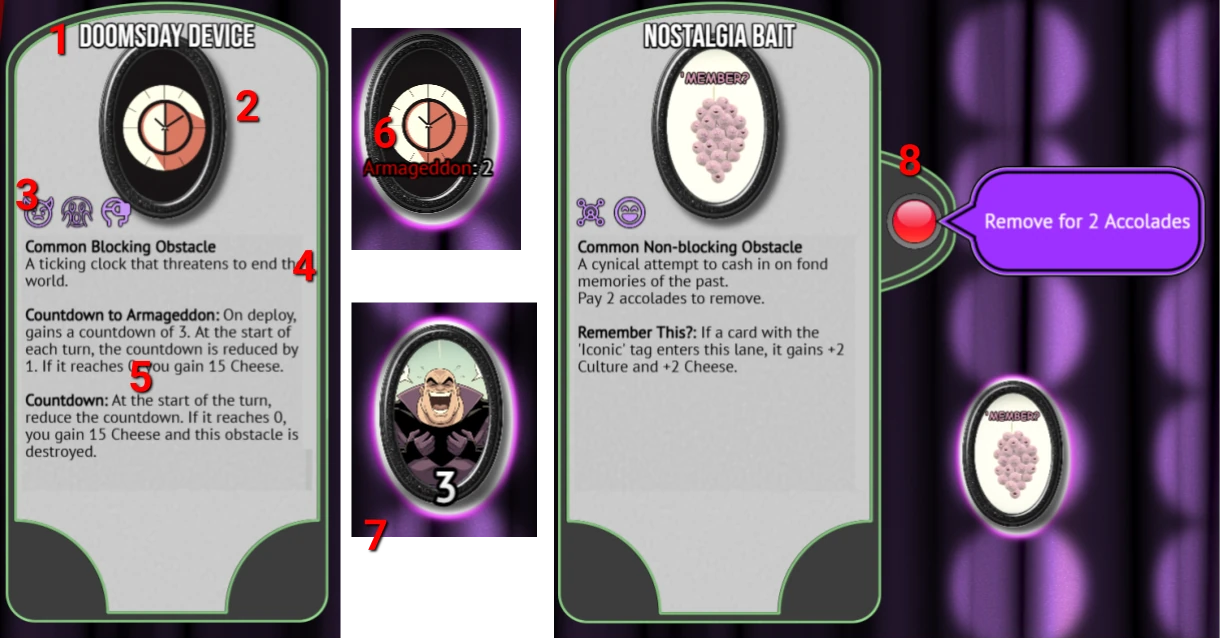
As with Cards, there are two representations of an Obstacle. Its existence on the board, and its appearance in the info panel when selected. Here’s a breakdown of the key properties:
- Name: Identifies the Obstacle
- Potrait: Visual depiction of the Obstacle
- Descriptors: Like cards, Obstacles can have Tags and Archetypes. While these do not interact with the Adversary in the same way they do on cards, many abilities target or affect only Obstacles with specific descriptors.
- Description: As well as providing a short description of what the Obstacle represents thematically, this area also shows:
- The rarity of the Obstacle: Common or Legendary
- Whether the Obstacle is Blocking or Non-blocking
- Abilities and Effects: Just like cards, Obstacles also have abilities and effects that trigger in different situations. Also like cards, these are initially hidden until the player triggers them (and then they stay visible forever).
- Counters: Some Obstacles (like the Doomsday Device depicted) can have associated counters added to them. Counters will always have a name. The Obstacle’s description will indicate what the counters are for. Most Obstacle do not have counters, though.
- Expiration: Several Obstacles expire after a given number of turns. This is shown by a large number at the bottom of the Obstacle (and is also shown in the info panel when selected). In this example, the Monologue obstacle shows that it expires in 3 turns. Expiration counts decrease at the end of each turn.
- Removal and Activated Abilities: Obstacles that are able to be removed will show a red button like this. Clicking the button will remove the obstacle immediately after deducting the specified cost. Some Obstacles (especially Legendary ones) have activated abilities or removal criteria that are not as simple. Those Obstacles will explain how they work in the info panel.
Obstacle Types
Obstacles come in two main flavors (rarities):
- Common : These are common annoyances. They might have minor effects or simply get in your way.
- Legendary : These represent iconic and specific pop culture antagonists or concepts. They are much more powerful, often have global effects, and are harder to remove. Successfully removing a Legendary Obstacle unlocks a specific, powerful card for your collection!
How Obstacles Work
-
Deployment: At the start of each turn, the Adversary has a chance to deploy an Obstacle from their pool onto the board. They will almost never be placed in the bottom row, ensuring you always have a space to play new cards.
-
Blocking vs. Non-Blocking: Every obstacle is either Blocking or Non-blocking.
- A Blocking obstacle acts as a solid wall. A card cannot move into or through its space until the obstacle is removed.
- A Non-blocking obstacle allows cards to move into its space, but doing so will typically trigger a negative
onLandedeffect.
-
Effects: If a player action or board situation triggers an obstacle’s effects, it will show a speech bubble, just like cards do.
Removing Obstacles
Getting rid of obstacles is crucial to keeping your lanes clear and your cards moving. While some card abilities are designed to remove them, many obstacles have a built-in removal method that doesn’t require a specific card.
These methods often require an activation cost, which you can pay during your Play Phase:
- Payment: Pay a one-time cost to clear the obstacle. This payment could be one of several types:
- A payment of
 ,
,  , or
, or 
- Accepting some amount of

- Discarding one or more cards
- A payment of
- Expiration: Some obstacles have a turn counter that ticks down. When it reaches zero, the obstacle removes itself.
Legendary Obstacles often have more complex and costly removal conditions, befitting their powerful nature.
Obstacle Abilities & Statuses
Like cards, obstacles have abilities that trigger based on game events (e.g. “when a card lands on this”, “when a card is blocked by this”, etc.). They can also be affected by Status Effects, which might disable their abilities or reduce their removal cost.
2.6 - The Shop
Between each encounter, you get to take a breather and visit the Shop. This is the primary way you’ll build your deck, discover new characters, and develop your strategy for the rest of the run.
Your Currency:  Accolades
Accolades
The Shop doesn’t take cash or credit. The only currency accepted here is ![]() Accolades, which you earn by successfully defeating Adversaries. The better you perform in an encounter (high
Accolades, which you earn by successfully defeating Adversaries. The better you perform in an encounter (high ![]() , low
, low ![]() ), the more
), the more ![]() Accolades you’ll earn. Any
Accolades you’ll earn. Any ![]() Hype you have left over is also converted into
Hype you have left over is also converted into ![]() Accolades.
Accolades.
What’s for Sale?
The shop, themed like a movie theater concession stand, offers a rotating selection of items.
Booster Packs
This is the main way you’ll acquire new cards. The shop will always offer a selection of booster packs which will provide an assortment of cards
that are thematically associated with the pack. For example, the Talking Heads pack might contain a selection of ![]() Journalist or
Journalist or ![]() Media-Personality cards, while the Cartoon Cavalcade of Cards contains mainly
Media-Personality cards, while the Cartoon Cavalcade of Cards contains mainly ![]() Animated characters.
Animated characters.
- Standard Booster: Contains 3 cards. Costs 3
 and you may select one to keep.
and you may select one to keep. - Mega Pack: Contains 5 cards. Costs 5
 , but you can select two cards to keep.
, but you can select two cards to keep.
Each booster pack is guaranteed to contain at least one card of Uncommon rarity or higher, and will never contain more than one Legendary.
Individual Cards
Sometimes, you’ll see individual cards for sale. This is a great way to grab a specific character you need to complete a synergy or fill a gap in your strategy. The price is based on the card’s rarity:
- Common
: 1

- Uncommon
: 2

- Rare
: 4

- Legendary
: 8

Choosing Your Cards
When you buy a booster pack, you don’t automatically get all the cards inside. You get to choose one card from a standard booster or two cards from a Mega Pack to add to your deck. This makes every purchase a strategic choice!
Note: During the initial deck draft at the very start of a run, you get to keep all the cards from the boosters you open.
Refreshing the Shop
Not inspired by the current selection? For a price, you can reroll the entire shop inventory.
- The initial cost is 4
 .
. - The cost to reroll increases each time you do it within the same shop phase.
- A reroll will never show you any of the items that were in the previous shop offering, so you’re guaranteed a fresh look.
2.7 - Your Collection
As you play The Scene, you’ll constantly discover new Cards, Obstacles, and Adversaries and reveal their hidden abilities. The Collection is your personal library where you can browse and admire every character and ability you’ve encountered on your journey through pop culture.
Here’s a sneak peek of what a collection page might look like (blurring some cards to prevent spoilers!).

Accessing Your Collection
You can access your Collection directly from the game’s main menu. It’s the perfect place to visit between runs to review your discoveries and strategize for your next attempt.
What’s Inside?
The Collection screen gives you a complete view of every Card, Obstacle, and Adversary you have ever seen in the game. For each, you can see:
- Full Details: All the stats, descriptors, and artwork.
- Revealed Abilities: Any ability that you have unlocked through gameplay will be fully visible here. If you haven’t triggered an ability yet, it will still appear as hidden (
???), waiting to be discovered in a future run.
Think of it as your own personal encyclopedia of pop culture. It’s a testament to your progress and a valuable tool for planning your next award-winning scene.
3 - FAQ
What is The Scene?
The Scene is a single-player, rogue-like deck-building game with a pop-culture mash-up theme. The goal is to build a successful “scene” by playing cards representing a diverse cast of characters and navigating various challenges.
How do I play The Scene?
Since The Scene is currently in closed alpha, it isn’t available to just anyone. If you’re interested in playing the prerelease version, please apply here.
How is this different from other deck-builders?
The Scene focuses on emergent synergies between characters from different fictional universes. Instead of abstract mechanics, the game is driven by a unique “Hype” and “Cheese” resource system.
When is the release date?
There is no official release date yet. Stay tuned to this website for future announcements!
4 - Reference
4.1 - Glossary
This glossary provides quick definitions for the main concepts in The Scene. For more detailed information, follow the links to the relevant documentation pages.
A
- Accolades
- The meta-currency earned by winning encounters, used to purchase items in the shop. Depicted by

- Adversary
- The opponent in an encounter, representing a Fandom or a Boss, which sets the victory conditions. See Adversaries.
- Actor
- A card with the
 Actor archetype that can be attached to a Role card to create a Portrayal.
Actor archetype that can be attached to a Role card to create a Portrayal.
B
- Board
- The main play area, consisting of four lanes where cards are played. See The Board.
- Booster Pack
- A pack of cards that can be acquired in the shop to add new cards to your deck.
- Boss
- A powerful, final Adversary at the end of a run.
C
- Card
- The primary tool of the game, representing a person, character, or group from pop culture. See Cards.
- Cheese
- A penalty resource representing controversy or tackiness. If you accumulate too much, you lose the encounter. See Core Concepts. Depicted by

- Collection
- Your personal library of all cards and abilities you have discovered, accessible from the main menu. See Your Collection.
- Cost
- The amount of
 Hype required to play a card from your hand.
Hype required to play a card from your hand. - Crew
- A special type of card played to the Crew Area, providing powerful, persistent effects. See Cards.
- Culture
- The main scoring metric. You win an encounter by reaching the required Culture score. See Core Concepts. Depicted by

D
- Deck
- The collection of cards you bring into an encounter. You draw cards from your deck to your hand.
- Discard Pile
- The area where cards go after being played or discarded.
E
F
- Fandom
- The standard type of Adversary you face throughout a run.
H
- Hand
- The cards currently available for you to play, visible at the bottom of the Board.
- Hype
- The primary resource used to pay the Cost of playing cards. See Core Concepts. Depicted by

L
- Lane
- One of the four vertical columns on the Board where cards are placed.
O
P
- Portrayal
- The result of attaching an Actor or Writer card to a Role card, which modifies the card’s performance. See Cards.
R
- Rarity
- The classification of a card’s mechanical complexity and power (Common , Uncommon , Rare , Legendary ).
- Role
- A type of card representing a fictional character or historical figure that can have Actors and Writers attached to it. See Cards.
- Run
- A single playthrough of the game, consisting of a series of Encounters.
S
- Score
- The action of a card reaching the top of a lane and contributing its
 Culture and
Culture and  Cheese to your totals.
Cheese to your totals. - Shop
- The phase between encounters where you can spend
 Accolades to purchase new cards and boosters. See The Shop.
Accolades to purchase new cards and boosters. See The Shop.
W
4.2 - Descriptors
Archetypes
 Actor: A master of disguise and emotional depth, this performer can step into any role. Actors can be played onto Fictional or Historical figures to Portray them, unlocking new Scene possibilities.
Actor: A master of disguise and emotional depth, this performer can step into any role. Actors can be played onto Fictional or Historical figures to Portray them, unlocking new Scene possibilities. Alien: Not from around here! This extraterrestrial archetype brings otherworldly flair and often, strange powers or unique perspectives from beyond the stars.
Alien: Not from around here! This extraterrestrial archetype brings otherworldly flair and often, strange powers or unique perspectives from beyond the stars. Animal: From furry friends to fearsome beasts, this archetype represents the wild side of pop culture. They often bring primal energy or unexpected connections.
Animal: From furry friends to fearsome beasts, this archetype represents the wild side of pop culture. They often bring primal energy or unexpected connections. Artist: A creator of beauty, meaning, or provocation, this individual expresses themselves through various mediums. Their work often inspires, challenges, or reflects the Scene itself.
Artist: A creator of beauty, meaning, or provocation, this individual expresses themselves through various mediums. Their work often inspires, challenges, or reflects the Scene itself. Athlete: A champion of the arena, court, or field, this individual excels in physical challenges. Their prowess often generates excitement through impressive feats and helps overcome physical obstacles.
Athlete: A champion of the arena, court, or field, this individual excels in physical challenges. Their prowess often generates excitement through impressive feats and helps overcome physical obstacles. Chef: A culinary wizard, transforming humble ingredients into gastronomic delights. This individual can whip up interest from hungry Fandoms or add flavorful depth to your Scene.
Chef: A culinary wizard, transforming humble ingredients into gastronomic delights. This individual can whip up interest from hungry Fandoms or add flavorful depth to your Scene. Comedian: Armed with a microphone and a punchline, this professional humorist specializes in making audiences laugh. They often alleviate tension or generate appeal with a perfectly timed joke.
Comedian: Armed with a microphone and a punchline, this professional humorist specializes in making audiences laugh. They often alleviate tension or generate appeal with a perfectly timed joke. Creature: Not a human, this thing is brought to life by special effects. Creatures do not require an Actor or Writer to be attached to them in order for them to score, making them valuable additions to any Scene!
Creature: Not a human, this thing is brought to life by special effects. Creatures do not require an Actor or Writer to be attached to them in order for them to score, making them valuable additions to any Scene! Crew: The unsung heroes of any production, these individuals work behind the camera. Crew cards played to their dedicated area provide powerful global effects, enhancing your entire Scene.
Crew: The unsung heroes of any production, these individuals work behind the camera. Crew cards played to their dedicated area provide powerful global effects, enhancing your entire Scene. Demihuman: Almost human, but with a fantastical twist – elves, dwarves, hobbits, oh my! This archetype brings unique racial abilities and adds magical depth to any Scene.
Demihuman: Almost human, but with a fantastical twist – elves, dwarves, hobbits, oh my! This archetype brings unique racial abilities and adds magical depth to any Scene. Group: A collective of individuals, working (or arguing) in unison. This archetype represents bands, teams, or any collection of personalities, amplifying influence through sheer numbers or harmonious synergies.
Group: A collective of individuals, working (or arguing) in unison. This archetype represents bands, teams, or any collection of personalities, amplifying influence through sheer numbers or harmonious synergies. Historical Figure: Hailing from the annals of time, this character made their mark on reality. They bring gravitas and factual weight to any Scene.
Historical Figure: Hailing from the annals of time, this character made their mark on reality. They bring gravitas and factual weight to any Scene. Human: Just your average bipedal, reasoning (sometimes) creature. These familiar faces form the backbone of many Scenes, offering a reliable presence.
Human: Just your average bipedal, reasoning (sometimes) creature. These familiar faces form the backbone of many Scenes, offering a reliable presence. Journalist: Armed with a pen and a keen nose for a story, this truth-seeker investigates and reports. They often expose hidden truths or uncover important facts.
Journalist: Armed with a pen and a keen nose for a story, this truth-seeker investigates and reports. They often expose hidden truths or uncover important facts. Media Personality: The face (or voice) of public entertainment, this individual commands attention. They often manipulate public interest and shape narratives.
Media Personality: The face (or voice) of public entertainment, this individual commands attention. They often manipulate public interest and shape narratives. Monster: A terrifying titan or a misunderstood creature, this archetype lurks in the shadows. They often add a chilling layer to any Scene, an imposing presence.
Monster: A terrifying titan or a misunderstood creature, this archetype lurks in the shadows. They often add a chilling layer to any Scene, an imposing presence. Musician: Hitting all the right notes, this individual creates harmonious appeal or a cacophony of discord. Their performances often transform the mood of any Scene.
Musician: Hitting all the right notes, this individual creates harmonious appeal or a cacophony of discord. Their performances often transform the mood of any Scene. Object: The inanimate, yet iconic. This archetype covers significant items that shape pop culture. They can subtly influence any Scene or provide a static presence.
Object: The inanimate, yet iconic. This archetype covers significant items that shape pop culture. They can subtly influence any Scene or provide a static presence.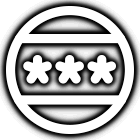 Politician: A master of compromise, debate, and the occasional flip-flop. This individual navigates the complex world of public opinion, often influencing Fandoms or overcoming bureaucratic hurdles.
Politician: A master of compromise, debate, and the occasional flip-flop. This individual navigates the complex world of public opinion, often influencing Fandoms or overcoming bureaucratic hurdles. Puppet: More than just a doll on strings, this character is animated by an unseen hand. Their charm can be manipulated to surprising effect, often revealing hidden appeal.
Puppet: More than just a doll on strings, this character is animated by an unseen hand. Their charm can be manipulated to surprising effect, often revealing hidden appeal. Scientist: With lab coats and complex equations, this individual seeks to understand the universe. Their discoveries often generate breakthroughs or solve technological challenges.
Scientist: With lab coats and complex equations, this individual seeks to understand the universe. Their discoveries often generate breakthroughs or solve technological challenges. Superhero: Faster than a speeding bullet, more powerful than a locomotive! This champion fights for justice, delivering massive appeal and protecting any Scene from villainous threats.
Superhero: Faster than a speeding bullet, more powerful than a locomotive! This champion fights for justice, delivering massive appeal and protecting any Scene from villainous threats. Supervillain: Cackling maniacally and plotting world domination, this powerhouse of evil thrives on chaos. Their presence often increases tension, and they are known for overcoming obstacles.
Supervillain: Cackling maniacally and plotting world domination, this powerhouse of evil thrives on chaos. Their presence often increases tension, and they are known for overcoming obstacles. Synthetic: More machine than man (or beast), this artificial lifeform brings a logical, often calculating presence, a testament to advanced creation.
Synthetic: More machine than man (or beast), this artificial lifeform brings a logical, often calculating presence, a testament to advanced creation. Token: Tokens are special cards created by certain talents and serve a specialized purpose. They may represent an object, generic character, or concept.
Token: Tokens are special cards created by certain talents and serve a specialized purpose. They may represent an object, generic character, or concept. Toy: A child’s plaything!
Toy: A child’s plaything! Vehicle: From souped-up cars to spaceships, this archetype provides a swift entrance or a daring escape, a dynamic force in any Scene.
Vehicle: From souped-up cars to spaceships, this archetype provides a swift entrance or a daring escape, a dynamic force in any Scene. Writer: A wordsmith who crafts narratives, this individual can re-write the story of any Scene. They can Author other cards, unlocking powerful creative effects.
Writer: A wordsmith who crafts narratives, this individual can re-write the story of any Scene. They can Author other cards, unlocking powerful creative effects.
Tags
 Acrobatic: Twisting, flipping, and defying gravity, this individual is known for nimble grace and daring feats.
Acrobatic: Twisting, flipping, and defying gravity, this individual is known for nimble grace and daring feats. Action: This individual or character is defined by thrilling stunts, explosive confrontations, and a knack for high-stakes situations. Whether on screen or in a narrative, their presence promises excitement and a dramatic turn of events.
Action: This individual or character is defined by thrilling stunts, explosive confrontations, and a knack for high-stakes situations. Whether on screen or in a narrative, their presence promises excitement and a dramatic turn of events. Animated: This character’s charm is literally drawn; often seen in cartoons, stop-motion, or CGI. They bring a unique visual flair to any Scene.
Animated: This character’s charm is literally drawn; often seen in cartoons, stop-motion, or CGI. They bring a unique visual flair to any Scene. Anti-hero: Too morally grey for the hero’s cape, too charming for a villain’s lair. They operate on their own code, often with unpredictable outcomes.
Anti-hero: Too morally grey for the hero’s cape, too charming for a villain’s lair. They operate on their own code, often with unpredictable outcomes. Anthropomorphic: This character embodies human traits while being a non-human entity, be it an animal, object, or abstract concept. They bring a unique blend of relatability and the unexpected.
Anthropomorphic: This character embodies human traits while being a non-human entity, be it an animal, object, or abstract concept. They bring a unique blend of relatability and the unexpected. Ball: It’s a ball.
Ball: It’s a ball. Blind: Though sightless, their other senses are finely tuned. This individual navigates the Scene by intuition, often perceiving what others miss.
Blind: Though sightless, their other senses are finely tuned. This individual navigates the Scene by intuition, often perceiving what others miss. British: Stiff upper lip and a penchant for tea, this chap (or chapette) radiates quintessential British charm and sophistication.
British: Stiff upper lip and a penchant for tea, this chap (or chapette) radiates quintessential British charm and sophistication. Buffoon: Whether by design or pure accident, this character excels at comedic chaos. Their presence can often lighten tense situations.
Buffoon: Whether by design or pure accident, this character excels at comedic chaos. Their presence can often lighten tense situations. Cerebral: This individual or character is defined by their exceptional mental prowess, sharp wit, or profound knowledge. Their brilliance often unveils hidden truths or devises intricate solutions.
Cerebral: This individual or character is defined by their exceptional mental prowess, sharp wit, or profound knowledge. Their brilliance often unveils hidden truths or devises intricate solutions. Comedic: Naturally hilarious, they don’t need a stand-up routine to get a laugh. Their presence often lightens the mood.
Comedic: Naturally hilarious, they don’t need a stand-up routine to get a laugh. Their presence often lightens the mood. Comics: Hailing from the paneled pages of sequential art, this character leaps off the paper and into your Scene.
Comics: Hailing from the paneled pages of sequential art, this character leaps off the paper and into your Scene. Communicator: A master of rhetoric, able to sway crowds with a single speech. They are known for influencing public perception or convincing others to see things their way.
Communicator: A master of rhetoric, able to sway crowds with a single speech. They are known for influencing public perception or convincing others to see things their way. Controversial: This individual or group is known for sparking debate and strong reactions, whether due to polarizing views, notable scandals, or provocative public presence. They are magnets for discussion, for better or worse.
Controversial: This individual or group is known for sparking debate and strong reactions, whether due to polarizing views, notable scandals, or provocative public presence. They are magnets for discussion, for better or worse. Dad: Sporting cargo shorts and an endless supply of groan-worthy puns, this figure embodies the quintessential paternal presence. They often bring a sense of stability or a well-timed Dad Joke.
Dad: Sporting cargo shorts and an endless supply of groan-worthy puns, this figure embodies the quintessential paternal presence. They often bring a sense of stability or a well-timed Dad Joke. Deaf: Experiencing the world through other senses, this individual’s unique perspective often reveals unexpected solutions or allows them to perceive beyond typical disruptions.
Deaf: Experiencing the world through other senses, this individual’s unique perspective often reveals unexpected solutions or allows them to perceive beyond typical disruptions. Debunker: Armed with facts and a healthy dose of skepticism, they tear down hoaxes and expose fraud.
Debunker: Armed with facts and a healthy dose of skepticism, they tear down hoaxes and expose fraud. Documentary: A purveyor of truth and unfiltered reality, this individual seeks out genuine moments, often exposing the artificiality of a Scene.
Documentary: A purveyor of truth and unfiltered reality, this individual seeks out genuine moments, often exposing the artificiality of a Scene. Dramatic: This individual or character is known for their intensely compelling performances and roles, often bringing profound depth and gravitas to any Scene.
Dramatic: This individual or character is known for their intensely compelling performances and roles, often bringing profound depth and gravitas to any Scene. Fantasy: Hailing from realms of magic and myth, this character brings an aura of wonder and often, unique powers.
Fantasy: Hailing from realms of magic and myth, this character brings an aura of wonder and often, unique powers. Female: This individual is (or primarily identifies as) Female.
Female: This individual is (or primarily identifies as) Female. Fictional: This character sprung from the boundless imagination of humanity, existing purely in story, screen, song, or video game.
Fictional: This character sprung from the boundless imagination of humanity, existing purely in story, screen, song, or video game. Flamboyant: Known for their extravagant style, theatrical gestures, and a flair for the dramatic, this individual commands attention and brightens any Scene with their vibrant presence.
Flamboyant: Known for their extravagant style, theatrical gestures, and a flair for the dramatic, this individual commands attention and brightens any Scene with their vibrant presence. Flying: Soaring above the fray, this character is known for bypassing certain obstacles or reaching new heights of influence.
Flying: Soaring above the fray, this character is known for bypassing certain obstacles or reaching new heights of influence. Franchise: Part of a sprawling universe of lore, this character belongs to a popular series. Their presence alongside other characters from the same Franchise often creates epic narratives.
Franchise: Part of a sprawling universe of lore, this character belongs to a popular series. Their presence alongside other characters from the same Franchise often creates epic narratives. Hearthrob: So charming, they could melt polar ice caps. This individual captures hearts and minds, a magnet for attention.
Hearthrob: So charming, they could melt polar ice caps. This individual captures hearts and minds, a magnet for attention. Heroic: A paragon of virtue and courage, this individual stands as a beacon of hope. They are defined by selfless acts, unwavering resolve, and a commitment to protecting the innocent, often inspiring others to greatness.
Heroic: A paragon of virtue and courage, this individual stands as a beacon of hope. They are defined by selfless acts, unwavering resolve, and a commitment to protecting the innocent, often inspiring others to greatness. Holiday: Deck the halls with boughs of holly, this character embodies the spirit of a specific celebration. Their presence often evokes seasonal cheer.
Holiday: Deck the halls with boughs of holly, this character embodies the spirit of a specific celebration. Their presence often evokes seasonal cheer. Horror: A creature of the night or a master of suspense, this character is designed to terrify. They often manipulate the mood or instill fear in Adversaries.
Horror: A creature of the night or a master of suspense, this character is designed to terrify. They often manipulate the mood or instill fear in Adversaries. Iconic: Beyond mere fame, this individual or character is truly transcendent, so deeply ingrained in global consciousness they feel almost real. Their presence elevates any Scene to legendary status.
Iconic: Beyond mere fame, this individual or character is truly transcendent, so deeply ingrained in global consciousness they feel almost real. Their presence elevates any Scene to legendary status. Irreverent: This individual is known for their bold, often provocative humor, unafraid to challenge norms or offend sensibilities. They say what others only dare to think.
Irreverent: This individual is known for their bold, often provocative humor, unafraid to challenge norms or offend sensibilities. They say what others only dare to think. Literary: This character leaps from the written word into any Scene, bringing a rich narrative quality and timeless appeal.
Literary: This character leaps from the written word into any Scene, bringing a rich narrative quality and timeless appeal. Magical: From literal spell-slingers to those who conjure awe-inspiring spectacles, this individual or group evokes a sense of fantastical wonder. Their presence often imbues a Scene with enchantment and unexpected possibilities.
Magical: From literal spell-slingers to those who conjure awe-inspiring spectacles, this individual or group evokes a sense of fantastical wonder. Their presence often imbues a Scene with enchantment and unexpected possibilities. Male: This individual is (or primarily identifies as) Male.
Male: This individual is (or primarily identifies as) Male. Martial Artist: With fists of fury and feet of lightning, this master of combat is adept at navigating physical obstacles and delivering swift resolutions.
Martial Artist: With fists of fury and feet of lightning, this master of combat is adept at navigating physical obstacles and delivering swift resolutions. Member: This individual is a well-known personality who is part of a larger, distinct group (like a band, sports team, or fictional ensemble).
Member: This individual is a well-known personality who is part of a larger, distinct group (like a band, sports team, or fictional ensemble). Military: Prepared for battle and strategic maneuvers, this individual brings discipline and tactical advantage to any Scene.
Military: Prepared for battle and strategic maneuvers, this individual brings discipline and tactical advantage to any Scene. Millionaire: Living in the lap of luxury, this individual often finds ways to navigate trouble or fund lavish Scene productions.
Millionaire: Living in the lap of luxury, this individual often finds ways to navigate trouble or fund lavish Scene productions. Mom: The heart of the family, often dispensing wisdom or a healthy dose of tough love. This nurturing presence often stabilizes a Scene or provides unexpected support.
Mom: The heart of the family, often dispensing wisdom or a healthy dose of tough love. This nurturing presence often stabilizes a Scene or provides unexpected support. Monochrome: A blast from the past, this classic character hails from the golden age of black and white. They evoke nostalgia and a timeless aesthetic.
Monochrome: A blast from the past, this classic character hails from the golden age of black and white. They evoke nostalgia and a timeless aesthetic. Mystical: Shrouded in enigma and ancient lore, this character taps into unseen energies. Their presence often unveils hidden truths or creates unpredictable Scene effects.
Mystical: Shrouded in enigma and ancient lore, this character taps into unseen energies. Their presence often unveils hidden truths or creates unpredictable Scene effects. Mythical: Born from ancient tales and epic sagas, this legendary figure brings a timeless aura and powerful abilities to any Scene.
Mythical: Born from ancient tales and epic sagas, this legendary figure brings a timeless aura and powerful abilities to any Scene. Obsessed: Dangerously dedicated to a singular fixation, this individual pursues their goal relentlessly. Their intense focus can generate significant interest, but beware of potential pitfalls.
Obsessed: Dangerously dedicated to a singular fixation, this individual pursues their goal relentlessly. Their intense focus can generate significant interest, but beware of potential pitfalls. Optimistic: Always looking on the bright side, this individual spreads good vibes. Their positive outlook often reduces tension or inspires others to greater heights.
Optimistic: Always looking on the bright side, this individual spreads good vibes. Their positive outlook often reduces tension or inspires others to greater heights. Professional: Clocking in for duty, this individual represents a specific career. Their expertise often provides advantages in specific situations or helps overcome particular challenges.
Professional: Clocking in for duty, this individual represents a specific career. Their expertise often provides advantages in specific situations or helps overcome particular challenges. Psychic: Able to tap into the collective consciousness, or at least pretend to. This individual often perceives the hidden thoughts of others, bringing an uncanny awareness to the Scene.
Psychic: Able to tap into the collective consciousness, or at least pretend to. This individual often perceives the hidden thoughts of others, bringing an uncanny awareness to the Scene. Quirky: Marching to the beat of their own drum, this character defies convention. Their peculiar charm often attracts niche Fandoms and provides unconventional solutions.
Quirky: Marching to the beat of their own drum, this character defies convention. Their peculiar charm often attracts niche Fandoms and provides unconventional solutions. Relatable: Just like us, only famous! This individual connects with audiences, making any Scene feel more authentic.
Relatable: Just like us, only famous! This individual connects with audiences, making any Scene feel more authentic. Religious: Guided by faith or a higher calling, this individual can inspire devotion and provide depth through spiritual connections.
Religious: Guided by faith or a higher calling, this individual can inspire devotion and provide depth through spiritual connections. Romantic: A lover, not a fighter (usually). This individual adds an emotional dimension to any Scene, potentially inspiring passionate appeal or reducing conflict.
Romantic: A lover, not a fighter (usually). This individual adds an emotional dimension to any Scene, potentially inspiring passionate appeal or reducing conflict. Royal: This individual holds a position of regal authority, whether by birthright, marriage, or popular acclamation. Their presence brings an air of majesty and command to any Scene.
Royal: This individual holds a position of regal authority, whether by birthright, marriage, or popular acclamation. Their presence brings an air of majesty and command to any Scene. Science Fiction: From galaxies far, far away or futures yet to come, this character brings advanced tech and futuristic concepts to any Scene.
Science Fiction: From galaxies far, far away or futures yet to come, this character brings advanced tech and futuristic concepts to any Scene. Silent: Their actions speak louder than words. This character communicates through expressive gestures, often appearing immune to certain verbal obstacles or effects.
Silent: Their actions speak louder than words. This character communicates through expressive gestures, often appearing immune to certain verbal obstacles or effects. Simple-minded: Blissfully unaware of complexities, this character approaches the world with an uncomplicated charm. They sometimes unexpectedly sidestep psychological challenges.
Simple-minded: Blissfully unaware of complexities, this character approaches the world with an uncomplicated charm. They sometimes unexpectedly sidestep psychological challenges. Slapstick: Tripping, bumbling, and pratfalling their way to hilarity, this character specializes in physical comedy. Their antics often create unexpected moments and draw attention.
Slapstick: Tripping, bumbling, and pratfalling their way to hilarity, this character specializes in physical comedy. Their antics often create unexpected moments and draw attention. Spy: Masters of disguise and clandestine operations, this individual can infiltrate enemy lines, gather vital intel, and discreetly work against Adversaries.
Spy: Masters of disguise and clandestine operations, this individual can infiltrate enemy lines, gather vital intel, and discreetly work against Adversaries. Technological: This individual, character, or object is deeply intertwined with advanced technology, innovative gadgets, or futuristic concepts. Their essence is often defined by their connection to the cutting edge.
Technological: This individual, character, or object is deeply intertwined with advanced technology, innovative gadgets, or futuristic concepts. Their essence is often defined by their connection to the cutting edge. Terrifying: Guaranteed to send shivers down your spine. This character instills fear, which may cause Fandoms to react strongly or create an unsettling atmosphere.
Terrifying: Guaranteed to send shivers down your spine. This character instills fear, which may cause Fandoms to react strongly or create an unsettling atmosphere.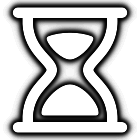 Time-traveler: Skipping through epochs and paradoxes, this character arrives from any point in history (or future). Their anachronistic presence often alters the Scene’s timeline.
Time-traveler: Skipping through epochs and paradoxes, this character arrives from any point in history (or future). Their anachronistic presence often alters the Scene’s timeline. Toy: A child’s plaything!
Toy: A child’s plaything! True-crime: Delving into the darker side of reality, this individual unearths grim truths and unsolved mysteries. They often uncover hidden flaws or generate intense interest from a morbidly curious Fandom.
True-crime: Delving into the darker side of reality, this individual unearths grim truths and unsolved mysteries. They often uncover hidden flaws or generate intense interest from a morbidly curious Fandom. Undead: Back from the grave (or just eternally haunting), this character defies the laws of biology. Their spooky presence often chills the atmosphere.
Undead: Back from the grave (or just eternally haunting), this character defies the laws of biology. Their spooky presence often chills the atmosphere. Unhinged: Operating on a completely different wavelength, this character’s unpredictability can be a chaotic boon or a delightful disaster. They often throw off an Adversary’s expectations.
Unhinged: Operating on a completely different wavelength, this character’s unpredictability can be a chaotic boon or a delightful disaster. They often throw off an Adversary’s expectations. Video Game: Leaping from pixels to reality, this character brings a retro or cutting-edge flair. They often interact with player-driven narratives or quest elements.
Video Game: Leaping from pixels to reality, this character brings a retro or cutting-edge flair. They often interact with player-driven narratives or quest elements. Villainous: A master of malevolence, this character revels in chaos and challenges. Their presence often increases tension, and they are known for overcoming obstacles.
Villainous: A master of malevolence, this character revels in chaos and challenges. Their presence often increases tension, and they are known for overcoming obstacles. Visionary: With a mind ahead of their time, this individual conceptualizes revolutionary ideas. They are known for inspiring groundbreaking Scenes.
Visionary: With a mind ahead of their time, this individual conceptualizes revolutionary ideas. They are known for inspiring groundbreaking Scenes.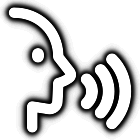 Voice: Whether a soothing narrator or a booming cosmic entity, this individual commands attention through sound. They often influence Fandoms through sheer vocal presence.
Voice: Whether a soothing narrator or a booming cosmic entity, this individual commands attention through sound. They often influence Fandoms through sheer vocal presence. Western: Howdy, partner! This character rides into your Scene straight from the dusty plains of the Wild West. Expect some rootin’ tootin’ action.
Western: Howdy, partner! This character rides into your Scene straight from the dusty plains of the Wild West. Expect some rootin’ tootin’ action. Wizard: Wielding staffs and incantations, this magic-user can conjure powerful effects and weave wondrous Synergies.
Wizard: Wielding staffs and incantations, this magic-user can conjure powerful effects and weave wondrous Synergies.
Obstacle Tags
 Bureaucratic: This obstacle, pursuant to sub-section 9 under article IX, notwithstanding provisions under clause 13a, is officially declared forthwith to be associated henceforth with the meticulous adherence to rules, regulations, and other bureaucratic nonsense. It demands patience and precision to overcome.
Bureaucratic: This obstacle, pursuant to sub-section 9 under article IX, notwithstanding provisions under clause 13a, is officially declared forthwith to be associated henceforth with the meticulous adherence to rules, regulations, and other bureaucratic nonsense. It demands patience and precision to overcome. Legal: A lawsuit, a subpoena, or a lengthy trial. This barrier requires careful maneuvering through the courts, often leading to justice or scandal.
Legal: A lawsuit, a subpoena, or a lengthy trial. This barrier requires careful maneuvering through the courts, often leading to justice or scandal. Logistical: A traffic jam, a misplaced package, or a missed connection. This barrier disrupts the flow of your Scene, requiring careful planning or clever workarounds.
Logistical: A traffic jam, a misplaced package, or a missed connection. This barrier disrupts the flow of your Scene, requiring careful planning or clever workarounds. Physical: A brick wall, a raging river, or a tangled jungle. This tangible barrier requires brute force or clever traversal to overcome.
Physical: A brick wall, a raging river, or a tangled jungle. This tangible barrier requires brute force or clever traversal to overcome. Psychological: A crisis of confidence, a mental block, or a pervasive fear. This internal barrier requires introspection or emotional fortitude to conquer.
Psychological: A crisis of confidence, a mental block, or a pervasive fear. This internal barrier requires introspection or emotional fortitude to conquer. Social: An awkward silence, a faux pas, or a clash of personalities. This obstacle arises from interpersonal dynamics, requiring charm, tact, or a perfectly timed witty remark to navigate.
Social: An awkward silence, a faux pas, or a clash of personalities. This obstacle arises from interpersonal dynamics, requiring charm, tact, or a perfectly timed witty remark to navigate.
4.3 - Status Effects
Card Statuses
 Award Nominee: This card costs 1
Award Nominee: This card costs 1  (in addition to its Hype cost) to play.
(in addition to its Hype cost) to play. Blacklisted: All this card’s abilities are inactive.
Blacklisted: All this card’s abilities are inactive. Box Office Flop: This card contributes no
Box Office Flop: This card contributes no  when scoring.
when scoring. Breakout Role: This card is not blocked by Obstacles.
Breakout Role: This card is not blocked by Obstacles. Canceled: This card cannot be attached to another card.
Canceled: This card cannot be attached to another card. Certified Fresh: This card cannot gain
Certified Fresh: This card cannot gain  .
. Cringeworthy: This card’s
Cringeworthy: This card’s  is doubled when scoring.
is doubled when scoring. Critically Acclaimed: This card’s
Critically Acclaimed: This card’s  value is doubled when scoring.
value is doubled when scoring. Cult Following: This card ignores the effects of non-Legendary Obstacles.
Cult Following: This card ignores the effects of non-Legendary Obstacles. Hype Train: This card moves 1 additional space during the movement phase.
Hype Train: This card moves 1 additional space during the movement phase. Immovable: This card cannot be moved by abilities.
Immovable: This card cannot be moved by abilities. In Demand: This card costs double its
In Demand: This card costs double its  to play.
to play.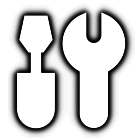 In Development: This card cannot be played from the hand.
In Development: This card cannot be played from the hand. Invulnerable: This card cannot be destroyed by other abilities.
Invulnerable: This card cannot be destroyed by other abilities. Method Acting: This card’s cost is increased by its
Method Acting: This card’s cost is increased by its  (paid with
(paid with  ).
). One-hit Wonder: This card is destroyed after scoring.
One-hit Wonder: This card is destroyed after scoring. Played Out: This card cannot gain
Played Out: This card cannot gain  .
. Publicity Stunt: This card’s cost is increased by its
Publicity Stunt: This card’s cost is increased by its  (paid with
(paid with  ).
).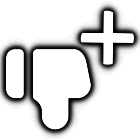 So Bad It’s Good: When scoring this card scores it’s
So Bad It’s Good: When scoring this card scores it’s  as
as  (in addition to its normal
(in addition to its normal  ).
). Stalled: This card does not move during the movement phase.
Stalled: This card does not move during the movement phase. Typecast: This card cannot be portrayed by a miscasting.
Typecast: This card cannot be portrayed by a miscasting. Under Contract: This card’s
Under Contract: This card’s  ,
,  , and
, and  cannot be modified by abilities.
cannot be modified by abilities. Under the Radar: This card’s
Under the Radar: This card’s  cost is halved.
cost is halved.
Global Statuses
 Captivated: All cards score 1.5x their
Captivated: All cards score 1.5x their  when scoring.
when scoring. Going Viral: All cards move 1 extra space during the movement phase.
Going Viral: All cards move 1 extra space during the movement phase. Guilty Pleasure: Cards do not score their
Guilty Pleasure: Cards do not score their  when scoring.
when scoring. Hooked: Liked Descriptors provide double the
Hooked: Liked Descriptors provide double the  Bonus.
Bonus. Jaded: Liked Descriptors provide no
Jaded: Liked Descriptors provide no  Bonus.
Bonus. On Edge: All cards score 1.5x their
On Edge: All cards score 1.5x their  when scoring.
when scoring. On Hiatus: The player does not draw cards at the start of their turn.
On Hiatus: The player does not draw cards at the start of their turn. Production Hell: No cards move during the movement phase.
Production Hell: No cards move during the movement phase. Unimpressed: All cards score 1/2 their
Unimpressed: All cards score 1/2 their  when scoring.
when scoring. Writer’s Block: The player cannot discard cards.
Writer’s Block: The player cannot discard cards.
Obstacle Statuses
 Budget Cuts: The removal cost of this obstacle is reduced by half.
Budget Cuts: The removal cost of this obstacle is reduced by half. Immovable: This obstacle cannot be moved by abilities.
Immovable: This obstacle cannot be moved by abilities. Invulnerable: This obstacle cannot be destroyed by other abilities.
Invulnerable: This obstacle cannot be destroyed by other abilities. Logistical Nightmare: This Obstacle’s abilities are disabled.
Logistical Nightmare: This Obstacle’s abilities are disabled. Reshoots: This non-blocking Obstacle’s Landed-on ability is disabled.
Reshoots: This non-blocking Obstacle’s Landed-on ability is disabled.